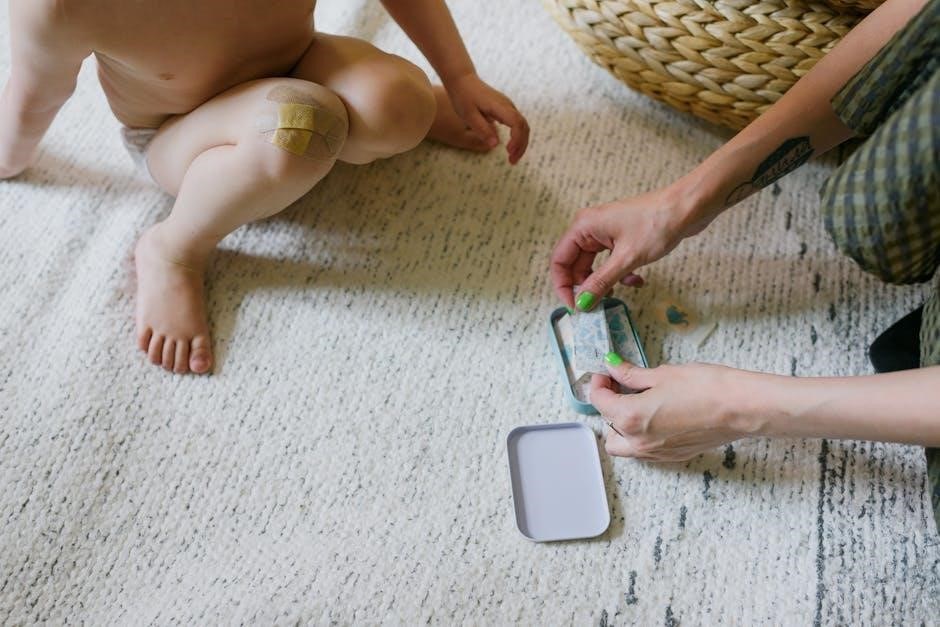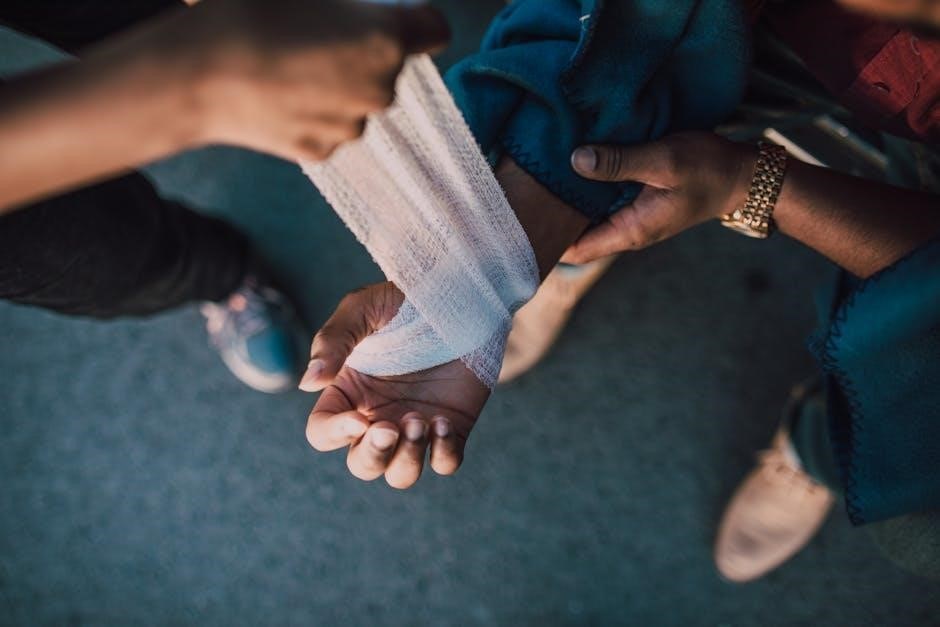first aid leveling guide
This guide provides a comprehensive approach to mastering first aid skills, essential for both gaming strategies and real-life emergencies, ensuring preparedness and confidence in critical situations.
1.1 Importance of First Aid in Gaming and Real Life
First aid is a vital skill that transcends virtual and real-world scenarios. In gaming, particularly in MMOs like World of Warcraft, first aid allows players to heal themselves and allies, enhancing team performance and survival. It provides strategic advantages, such as reducing downtime and maintaining combat readiness. In real life, first aid is crucial for responding to emergencies, preventing minor injuries from worsening, and saving lives. It empowers individuals to act confidently in critical situations, reducing panic and fostering a sense of responsibility. Whether in-game or real-world, first aid promotes preparedness, teamwork, and compassion, making it an essential skill for everyone.
1.2 Purpose of the First Aid Leveling Guide
The purpose of this guide is to provide a structured approach to mastering first aid skills, ensuring players and individuals can progress effectively in both gaming and real-life scenarios. It offers practical strategies, tips, and insights to enhance first aid proficiency, covering essential techniques and advanced methods. Designed for beginners and experienced users alike, the guide aims to bridge the gap between theoretical knowledge and practical application. By following this guide, users can improve their ability to respond confidently in emergencies, whether in virtual worlds or real-life situations, making it an invaluable resource for anyone seeking to elevate their first aid capabilities.

Basic First Aid Training
Mastering the fundamentals of first aid is crucial for immediate care in emergencies. Essential skills include wound cleaning, bandaging, and using antiseptics to prevent infection and promote healing effectively.
2.1 Understanding the Basics of First Aid
Mastering the fundamentals of first aid is crucial for effective emergency response. It begins with assessing the situation safely, ensuring no further harm occurs. Key principles include maintaining hygiene, using protective gear like gloves, and prioritizing life-threatening injuries. Basic techniques such as wound cleaning, bandaging, and controlling bleeding are essential. Understanding when and how to apply pressure or tourniquets can prevent severe blood loss. Additionally, recognizing signs of shock, burns, or fractures is vital. Familiarity with CPR and the recovery position saves lives. Always keep a first aid kit nearby, stocked with supplies like bandages, antiseptics, and gloves. Practice these skills regularly to build confidence and competence in emergencies.
2.2 Essential First Aid Skills for Beginners
Mastering basic first aid skills is crucial for beginners, starting with proper wound cleaning and bandaging. Learning to apply pressure to stop bleeding and using antiseptics to prevent infection are fundamental. Understanding how to assess injuries and prioritize care ensures effective assistance. Recognizing signs of shock, burns, or broken bones is also vital. Practicing these skills builds confidence and readiness for real-life emergencies. For gamers, these abilities translate to in-game strategies, enhancing team support and survival. Regular practice and staying calm under pressure are key to becoming proficient in first aid, whether in virtual or real-world scenarios.
Intermediate First Aid Techniques
This section covers advanced bandaging, wound management, and antiseptic use, building on basic skills to enhance preparedness for more serious injuries in both real-life and gaming scenarios.

3.1 Advanced Bandaging Methods
Advanced bandaging involves specialized techniques to secure dressings, immobilize injuries, and promote healing. Elastic bandages are ideal for sprains or strains, providing compression and support. Spiral or crisscross wrapping enhances flexibility, while figure-eight bandaging reinforces joints. For deep wounds, layered bandages with absorbent pads are recommended to control bleeding. Tourniquets are used in severe cases but require caution to avoid tissue damage. Proper bandaging prevents infection, reduces swelling, and accelerates recovery. Mastery of these methods ensures effective wound management in both emergency and non-emergency situations, making it a critical skill for first aid providers.
3.2 Managing Wounds and Bleeding
Effectively managing wounds and bleeding is a critical first aid skill, ensuring injuries heal properly and preventing infection. Start by assessing the wound to determine its depth and severity. Clean the area with sterile water or saline solution to remove dirt and bacteria. Apply direct pressure using a clean cloth or bandage to control bleeding, elevating the injured limb if possible. Minor wounds may heal with basic care, while deeper injuries require medical attention. Always use gloves to protect against bloodborne pathogens. Proper wound management reduces the risk of complications, promoting faster recovery and minimizing scarring. Immediate action is vital in such situations.
3.3 Use of Antiseptics and Disinfectants
Antiseptics and disinfectants are crucial in first aid for preventing infection and promoting healing. Antiseptics are applied directly to wounds to reduce microbial growth, while disinfectants are used to clean surfaces and equipment. Common antiseptics include iodine solutions and hydrogen peroxide, which should be used sparingly to avoid tissue damage. Disinfectants like bleach solutions are effective for non-living surfaces but not suitable for direct wound care. Proper use ensures a sterile environment, minimizing the risk of infection and supporting the recovery process. Always follow guidelines for concentration and application to maintain safety and effectiveness in first aid situations.

Advanced First Aid Procedures
Mastering complex injuries, multiple casualty scenarios, and specialized tools elevates first aid expertise, ensuring effective care in critical situations, both in real-life emergencies and gaming strategies.
4.1 Treating Broken Bones and Sprains
Treating broken bones and sprains requires immediate attention to prevent further injury. Immobilize the affected area using a sling or splint to avoid movement. Apply ice to reduce swelling and pain. For sprains, follow the RICE method: Rest, Ice, Compression, and Elevation. Administer over-the-counter pain relievers, but avoid moving the injury. Do not attempt to set broken bones without professional training. Seek immediate medical help for severe fractures or if the bone is exposed. Proper care ensures faster recovery and prevents long-term damage. Always prioritize professional medical evaluation for accurate diagnosis and treatment.
4.2 Handling Burns and Scalds
When dealing with burns or scalds, immediate action is crucial to prevent further damage. First, stop the burning process by removing the source of heat. Cool the affected area with cool or lukewarm water for 10-15 minutes. Never use ice, as it can cause further harm. Avoid applying butter, oil, or other substances, as they can trap heat. Cover the burn with a non-stick, sterile dressing to protect it from infection. For minor burns, over-the-counter pain relievers can help manage discomfort. However, for severe burns, seek professional medical attention immediately. Proper care can significantly reduce the risk of complications and promote healing.
4.3 Administering Antivenom and Emergency Medications
Administering antivenom and emergency medications is a critical skill in advanced first aid, particularly for treating bites, stings, or severe allergic reactions. Antivenom must be stored properly to maintain potency and should only be administered by trained individuals. Emergency medications, such as epinephrine auto-injectors, are essential for anaphylaxis. Always follow dosage instructions and monitor the patient’s condition closely after administration. Proper training is vital to ensure safe and effective use of these life-saving treatments. Understanding when and how to administer them can significantly improve outcomes in critical situations.
First Aid Materials and Equipment
A well-stocked first aid kit is crucial, including bandages, antiseptics, gloves, and medical tools. Proper equipment ensures effective wound care and management of injuries or illnesses promptly.
5.1 Types of Bandages and Their Uses
Bandages are essential in first aid for wound care and support. Adhesive strips are ideal for small cuts, while gauze pads absorb blood and protect wounds. Rolled gauze allows for easy wrapping of injuries, and elastic bandages provide compression and support for sprains or strains. Triangular bandages can be used as slings or to immobilize limbs. Each type serves a specific purpose, ensuring effective wound management and promoting healing. Proper selection and application of bandages are critical for optimal first aid care.
5.2 Importance of a First Aid Kit
A well-stocked first aid kit is essential for providing immediate care in emergencies. It ensures that basic medical supplies, such as bandages, antiseptics, and gloves, are readily available. Having a first aid kit on hand can prevent minor injuries from worsening and provides peace of mind. It also serves as a quick reference guide for first aid procedures. A properly organized kit helps first responders act efficiently, reducing the risk of further harm. Regularly updating and restocking the kit is crucial to maintain its effectiveness. A first aid kit is a vital tool for anyone trained in first aid, ensuring they can provide timely and appropriate care in critical situations.
5.3 Role of Medical Tools in First Aid
Medical tools play a vital role in first aid, enabling effective treatment of injuries and wounds. Essential tools include bandages, antiseptics, gloves, and splints, which help prevent infection and stabilize injuries. Bandages are crucial for wound care, while antiseptics ensure cleanliness. Gloves protect both the provider and the injured person from potential infections. Splints immobilize broken bones or sprains, reducing pain and preventing further damage. A well-stocked first aid kit with these tools is indispensable in emergencies, allowing for prompt and efficient care. Proper use of these tools requires training, emphasizing the importance of understanding their functions and applications in various scenarios.

Real-World Applications of First Aid
First aid is crucial in emergencies, workplaces, and outdoor settings, providing immediate care for injuries and preventing worsening conditions until professional help arrives, saving lives and reducing risks.
6.1 First Aid in Emergency Situations
In emergency situations, first aid is critical to prevent further harm and stabilize the injured until professional help arrives. Key steps include assessing the scene for safety, prioritizing life-threatening injuries, and providing immediate care. Techniques like CPR, wound management, and splinting are essential. Staying calm and acting swiftly can significantly improve outcomes. Proper training ensures effective decision-making under pressure, making first aid in emergencies a vital skill for everyone. Always follow established protocols to avoid causing additional harm. Preparation and quick thinking are paramount in saving lives during critical moments.
6.2 First Aid in Workplace Environments

First aid in workplace environments is crucial for ensuring employee safety and prompt medical response. Common injuries include cuts, burns, and sprains, which can be effectively managed with proper training. A well-stocked first aid kit and regular drills are essential. Employers should encourage a culture of safety, with designated first aiders trained to handle emergencies. Proper wound cleaning, bandaging, and use of antiseptics prevent infections. For severe injuries, immediate evacuation to medical facilities is vital. Psychological support for stressed employees post-incident is also important. Regular updates to first aid protocols ensure compliance with safety standards, fostering a secure work environment.
6.3 First Aid in Outdoor and Wilderness Settings
First aid in outdoor and wilderness settings requires unique skills due to limited resources and delayed medical help. Essential techniques include managing wounds, splinting fractures, and treating environmental injuries like burns or hypothermia. Knowledge of natural remedies and improvised tools is crucial. Staying calm and assessing situations accurately is vital. Proper use of a first aid kit and understanding when to evacuate are key. Training in wilderness first aid ensures preparedness for remote emergencies, emphasizing self-reliance and resourcefulness. This expertise is invaluable for hikers, campers, and adventurers, helping to save lives in isolated areas.

Psychological Aspects of First Aid
Mastering mental resilience, effective communication, and stress management are vital for first aid providers to remain calm, reassure patients, and deliver care confidently in high-pressure situations.
7.1 Staying Calm Under Pressure
Staying calm under pressure is crucial for effective first aid. Techniques like deep breathing, mental preparation, and focusing on the task at hand can help maintain composure. Practicing mindfulness and visualization beforehand can build confidence. Additionally, breaking down complex situations into manageable steps reduces overwhelm. Positive self-talk and recalling training can also stabilize emotions. Remember, staying calm ensures clearer decision-making and better care for the injured. Regular practice and exposure to simulated scenarios can enhance this skill, making it a cornerstone of reliable first aid response.

7.2 Communicating with the Injured Person
Effective communication is crucial when assisting an injured person. Always approach calmly, introduce yourself, and explain your intentions to build trust. Speak clearly and reassuringly to reduce anxiety. Ask concise questions to assess their condition, such as “Where are you hurt?” or “What happened?” Avoid overwhelming them with too many questions at once. Listen actively to their responses and observe non-verbal cues. Maintain eye contact to show empathy and attentiveness. If the person is unresponsive, check for breathing and follow basic life support protocols. Clear communication ensures proper assessment and appropriate care, making it a vital skill in first aid situations.
7.3 Dealing with Stress After Providing First Aid
Providing first aid can be emotionally taxing, leading to stress or anxiety. It’s important to acknowledge these feelings and engage in self-care activities to manage them effectively.
Practices like mindfulness, seeking support from peers, or talking to a professional can help alleviate emotional fatigue. Recognizing the value of your actions can also foster resilience and reduce stress.
Training and Certification
Enroll in reputable first aid courses, understand the certification process, and ensure regular renewal to maintain your credentials and stay updated with the latest techniques.
8.1 Finding Reliable First Aid Training Courses
Locating credible first aid training courses is crucial for mastering life-saving skills. Start by researching certified providers, such as the American Red Cross or St. John Ambulance, which offer structured programs. Online platforms like Coursera and Udemy provide accessible courses with flexible learning options. Ensure the curriculum aligns with current first aid standards and includes hands-on practice. Read reviews and ask for referrals to verify the quality of the training. Additionally, check if the course includes certification upon completion, which is often required for workplace or professional purposes. Prioritize courses that emphasize practical application and real-world scenarios to enhance your readiness in emergencies.
8.2 Certification Process for First Aid Providers

Obtaining first aid certification involves completing a recognized training course, often through organizations like the Red Cross or local medical institutions. These programs cover essential skills, practical demonstrations, and written exams to ensure proficiency. Upon successful completion, participants receive a certification valid for a specified period, typically two years. Renewal requires updating training and passing a recertification exam. Certification is crucial for workplace requirements and emergency response confidence. It also demonstrates a commitment to saving lives and providing care effectively. Proper documentation and verification processes ensure the credibility of first aid certifications, making them invaluable in both professional and community settings.
8.3 Renewal and Updating First Aid Certifications
Renewing and updating first aid certifications is crucial to maintain proficiency and adapt to new medical advancements. Most certifications expire after 2-3 years, requiring a renewal course. These courses often focus on updated techniques, such as improved wound management or new guidelines for CPR. Practitioners must complete continuing education hours or refresher training to stay certified. Regular updates ensure that first aid providers remain competent and aware of the latest best practices. Staying certified not only enhances skills but also demonstrates a commitment to providing reliable care in emergencies. Always check with your training provider for specific renewal requirements and available resources.

Resources for First Aid Learning
Explore recommended books, online courses, and mobile apps to enhance first aid knowledge and skills, ensuring practical and accessible learning for all skill levels.
9.1 Recommended Books on First Aid
Several books are highly recommended for mastering first aid skills, including “The First Aid Manual” by the British Red Cross, offering comprehensive guidance for emergencies. “First Aid for the USMLE Step 1” is ideal for medical students, while “Wilderness First Aid” by Buck Tilton focuses on outdoor scenarios. “First Aid Q&A for the USMLE Step 2 CK” provides practical case studies. These books are invaluable resources for both beginners and experienced practitioners, ensuring a solid understanding of first aid techniques and real-world applications.
9.2 Online Courses and Tutorials
Online courses and tutorials offer a flexible and accessible way to learn first aid skills. Platforms like Coursera, Udemy, and specialized medical websites provide structured lessons, videos, and interactive modules. These resources cover basic to advanced techniques, ensuring learners can progress at their own pace. Many courses include certifications upon completion, adding credibility to your skills. They often feature real-life scenarios, making the learning experience practical and engaging. Additionally, some platforms offer forums or communities for discussion, allowing learners to ask questions and share experiences. Online tutorials are particularly useful for gamers seeking to enhance their in-game first aid strategies, as they can be accessed anytime, anywhere, making them a valuable tool for continuous improvement.
9.3 Mobile Apps for First Aid Guidance
Mobile apps have revolutionized first aid training by providing instant access to life-saving techniques. Apps like the American Red Cross First Aid offer step-by-step guides for emergencies, including burns, wounds, and broken bones. They often feature interactive tutorials, videos, and quizzes to enhance learning. These tools are invaluable for gamers and real-life situations, ensuring quick reference during critical moments. Many apps also include emergency call features and location-based resources, making them indispensable for first aid providers. By leveraging technology, mobile apps bridge the gap between theoretical knowledge and practical application, empowering users to act confidently in emergencies.
10.1 Summary of Key Points
In conclusion, mastering first aid skills through this guide enhances both gaming success and real-life emergency preparedness, fostering confidence and teamwork. Continuous practice and knowledge sharing are essential.
10.1 Summary of Key Points
This guide has covered essential first aid skills, from basic wound care to advanced techniques like treating broken bones and burns. It emphasized the importance of proper materials, like bandages and antiseptics, and real-world applications in emergencies, workplaces, and outdoor settings. Psychological aspects, such as staying calm and communicating effectively, were also highlighted. The guide stressed the need for continuous learning through training, certifications, and resources like books, online courses, and apps. By mastering these elements, individuals can confidently provide first aid in critical situations, ensuring better outcomes and saving lives. Regular practice and staying updated are crucial for maintaining proficiency.
10.2 Encouragement to Practice and Share First Aid Knowledge
Practicing first aid skills regularly ensures readiness in emergencies, fostering confidence and competence. Sharing knowledge empowers others, creating a safer community. Teach friends, family, and teammates how to use bandages, antivenom, and basic techniques. Encourage others to learn and stay prepared, emphasizing the importance of teamwork in critical situations. By spreading awareness, you contribute to a collective ability to act decisively. Motivate others to pursue certification and stay updated on best practices. Remember, first aid is a vital skill that can make a significant difference in saving lives and reducing harm. Inspire others to embrace this knowledge and use it for the greater good.











Leave a Comment